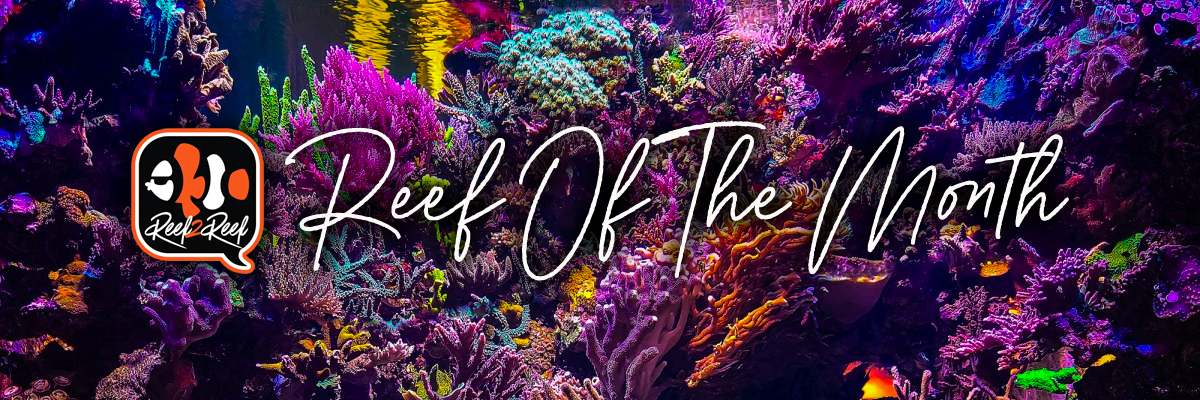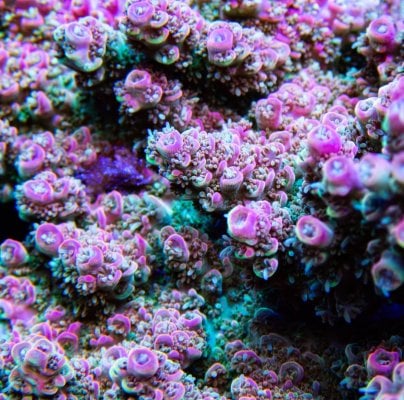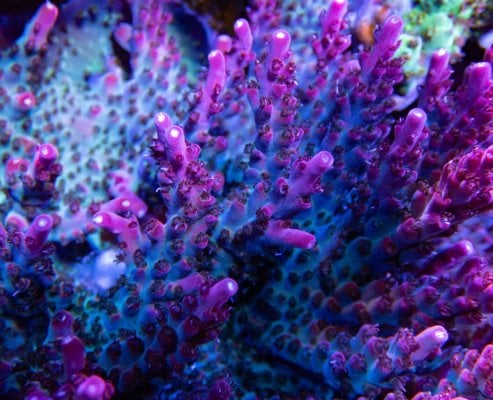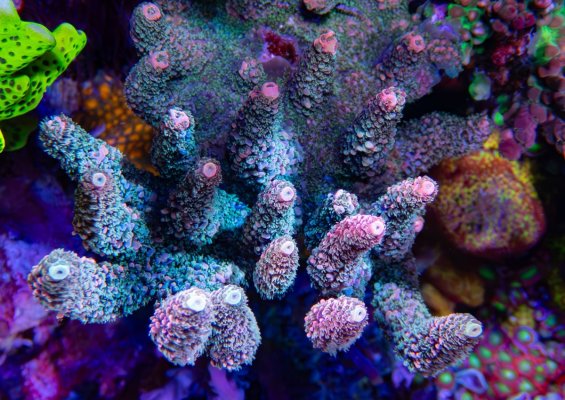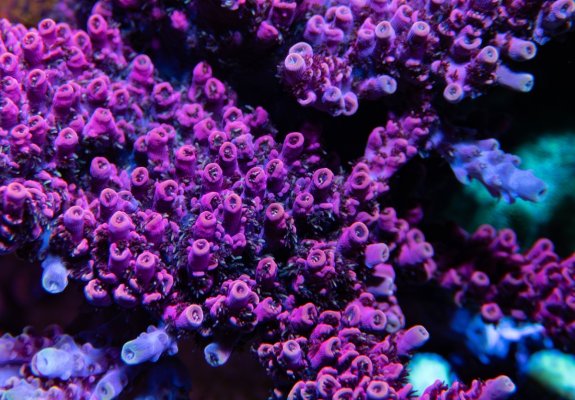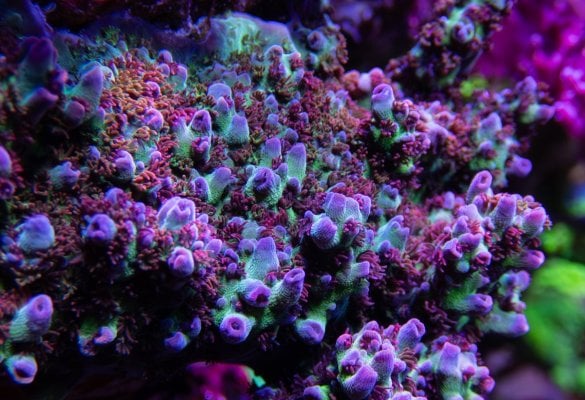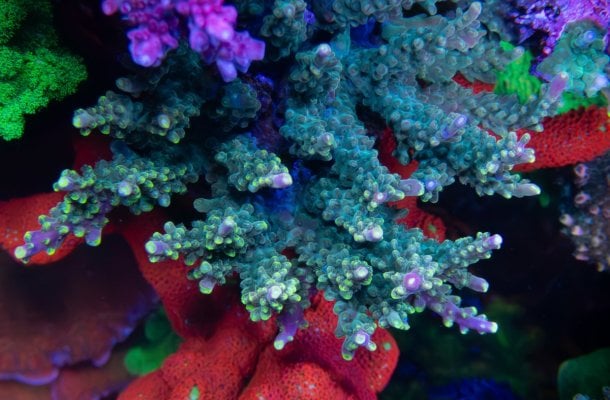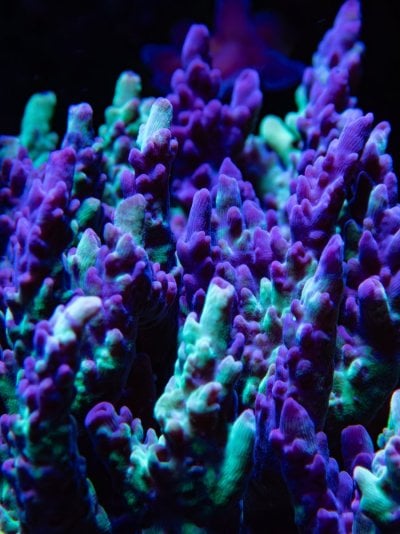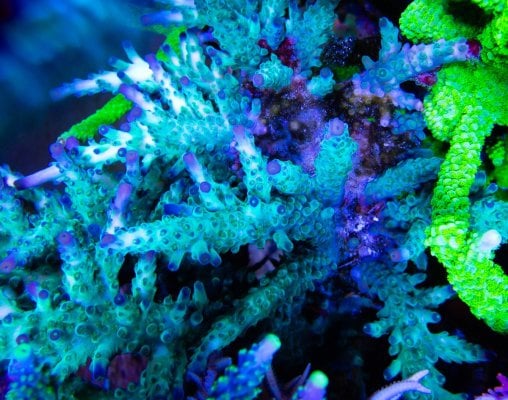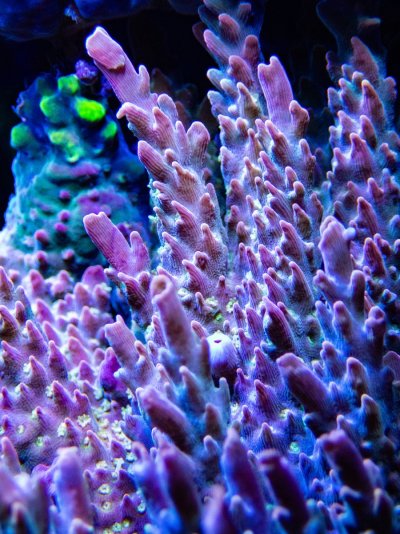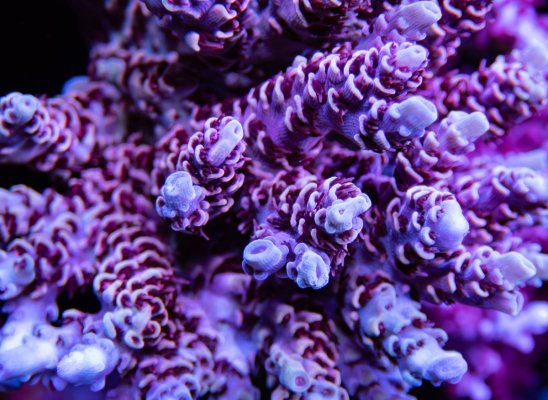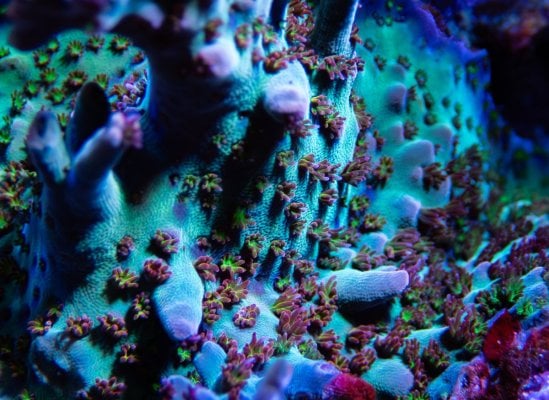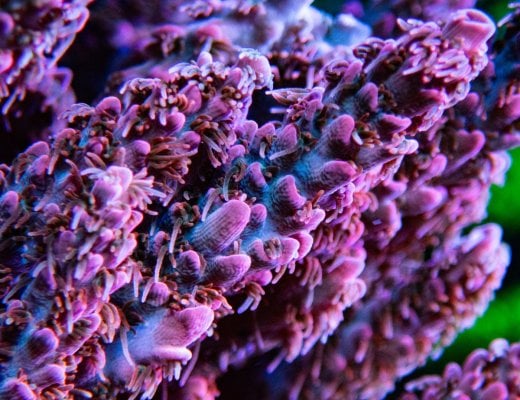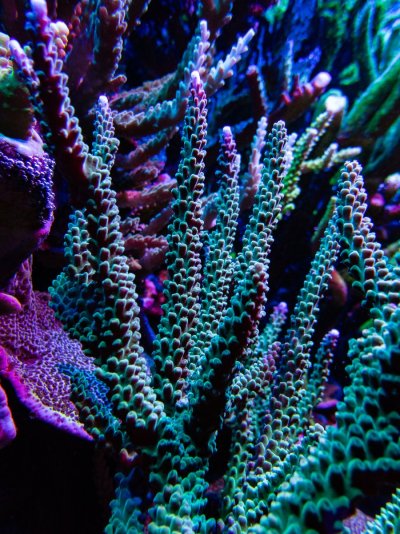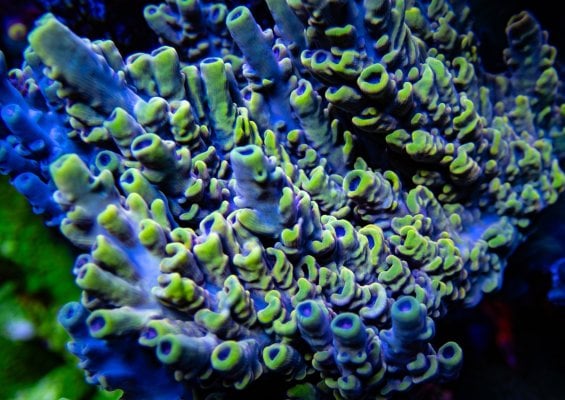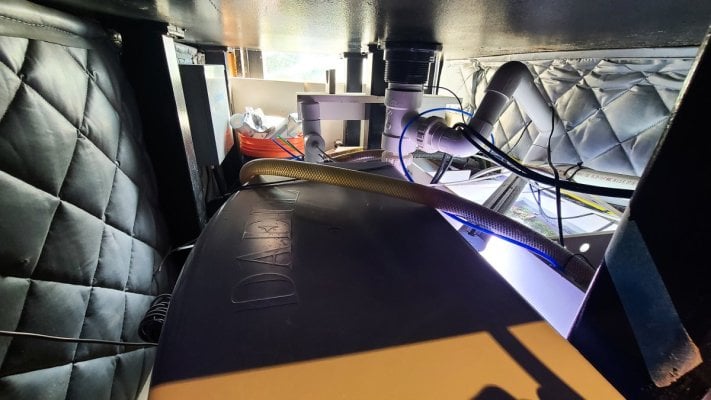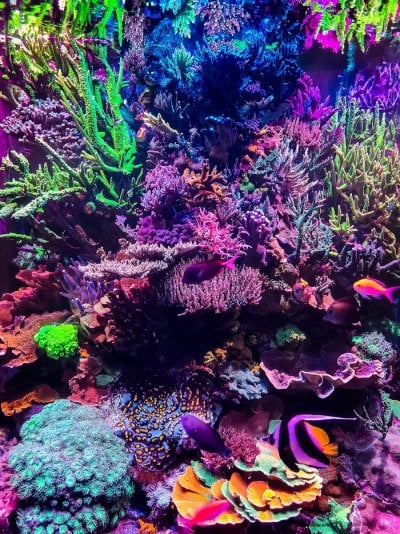Introduction: This month, we're excited to present this awe-inspiring reef from Austin, TX! This reef is owned by Dr. Billy Franklin and maintained by Wes Corbyn (@IntrinsicReef), owner of of Intrinsic Reef Design. Both of these men bring their unique visions and experiences as hobbyists to bear on the plan and formation of this beautiful reef, and so in this article, we will hear from both men with regard to the details of the design and vision of this reef system. Most of the answers below are provided by Wes, so unless exception is indicated, you can assume the maintenance plan is stated from his expertise. We're excited to present to you, the Reef of the Month for October 2023: Victory Reef! 650 Gallons of Thriving Marine Splendor!
Opening Thoughts:
Dr. Billy Franklin: My name is Billy Franklin. I am a Family Medicine physician in Austin, Texas. I never imagined our tank could ever be the Reef of the Month. Whether you would perceive me as innovative or oppositional-defiant depends on YOUR perspective, but in most things, I rarely follow convention. Though truly stunning, most ROTMs contain perfectly balanced and isolated colonies. While I admire and understand the practical aspects of this approach, my desire was to create a tank that looked WILD. My vision was something savage, chaotic, feral. This meant a tall display with massive (in my dream) corals. Polyps gathered from around the world, grafted to artificial rock and then placed in an acrylic container is anything but natural. Still, I wanted to convey in this simulated reality a sense of the coral making the decisions rather than the reef hobbyist. Fish were chosen mostly out of utility. The perfect synergy of polyp and zooxanthellae is king in this world. The tank is a custom build out of Florida that began life as a Dialyseas system that would theoretically eliminate the need for water changes.
The dimensions of the tank are 54" x 56" x 48" approximately and estimated to be approximately 650 gallons empty. Incrementalism over time added a custom sump along with a long list of gear. I am not proud of the fact, but I am the opposite of minimalistic. When I say “our” tank above, I am referencing Wes Corbyn of Intrinsic Reef who is the man who did the real work necessary to make my improbable fantasy tank into a reality. This is his tank as much as it is mine including being chosen for this honor.
Wes Corbyn of Intrinsic Reef Design: My name is Wes Corbyn and I own Intrinsic Reef Design in Austin, TX. I started my service company in 2008, and have maintained this reef for 7 years. We restarted this system from scratch in March 2019.
Photo by photos_by_mkay
System Profile:
- Display tank: 54" x 56" x 48" (650 gallons)
- Glass or Acrylic: Acrylic
- Stand:Steel
- Sump: 2 custom 48"x24"x28"T sumps plumbed together. First chamber is skimmer, 2nd is Live rock/ probe chamber, 3rd Sponge filters and carbon, 4th More live rock, 5th Submersible pumps, 6th Refugium with Caulerpa racemosa, 7th Return chamber
- Protein skimmer: Deltec 6000i in-sump skimmer
- Carbon/phosphate filtration: Carbon once a month, GFO in TLF reactor if needed
- Return pump: Vectra L2
- Water circulation: 4 EcoTech Vortech Mp60s, 2 Maxspect Gyre XF280s, and 3 Neptune Wavs
- Lighting (display): Lighting: 8 Ecotech Radion XR30 Pro, 2 Kessil A500x, 2 Kessil Ap700, 3 Kessil A160 Tuna Blue for spotlighting vertical rock columns
- Lighting (refugium): Pax Bellum C36, BuildmyLED 36"
- Calcium/alkalinity/magnesium dosing equipment: Neptune Dos x 2 ( 4 channels)
- Auto top-off: Neptune FMM
- Heating/cooling: JBJ 1.5HP Commercial chiller, Ebo-jager heaters
- System control: Neptune Apex
- Any other details: Pax Bellum A.R.I.D C36 Chaeto Reactor, Aqua UV 120 watt sterilizer, 6 stage RO/DI
A photo of the tank in its early development

Here it is today.

Photo by photos_by_mkay
Here it is today.
Photo by photos_by_mkay
Water Circulation and Flow Summary and Objectives: The circulation pumps are mounted on the equipment room side viewing panel. They are mounted in a vertical configuration spanning the 4ft vertical height and create a gyre around the center rock work.
Water Parameters:
- Temp: 76.5-78.5
- pH: 8.2-8.4 over the course of the week. Fluctuation only about .1 daily
- Specific gravity: 1.027
- NO3: Currently running around 20ppm of Nitrate. We have discussed lowering it, but coral coloration is good and minimal nuisance algae
- Ca: 400-450ppm I like to keep calcium on the high side. This gives a pool the corals can draw from if a dosing line gets clogged or pump fails.
- Alk: 10 dkh. I recently bumped up the soda ash to target an 8.3 average pH. The corals have responded well
- Mg: 1350pp
- PO4: .04-.12ppm The corals utilize so much phosphate that this number jumps around depending when I test
What kind of rock did you start with?
Real Reef Brand cultured rock. I stacked the center pyramid of rock around the overflow without epoxy or glue. I made a bottom ring and as I stacked upwards, the rock rings met in the center and became self supporting. The vertical columns have a PVC skeleton. We drilled center holes in the rock with a diamond tip bit and mounted to the skeleton. I have set up many tanks with Real Reef rock and have had great results. Cycles tanks almost immediately. We added fish and coral back in immediately after filling the tank with water.
What is your substrate? Nature's Ocean Live Sand
Calcium/Alkalinity/Magnesium Summary and Objectives:
I target pH and not alkalinity. I look at alkalinity as a buffer pool to keep the pH from falling. Personally, I think many hobbyists keep alk too low. The ocean has vast amounts of water to constantly replace minerals in water around the corals. The corals use these carbonates quickly in our small water volumes, and we get wide pH swings as a result. I test calcium weekly and adjust the doser as needed. We had a Neptune Trident on the system that was great for showing trends. Unfortunately, I struggle keeping those devices calibrated and trust my hand testing. I hand dose Magnesium weekly.
Photo by photos_by_mkay
What and how do you dose for the big 3 (alk/cal/mag)? Neptune Dos x2. The 1st channel doses 8700ml of RO water into the Kalkwasser stirrer daily, 2nd channel doses 1092ml of Soda Ash daily, 3rd channel doses 165ml of Red Sea Foundation A ( Calcium/ Strontium) daily, 4th channel doses minor and traces ( I custom mix according to ICP test).
Are you dosing anything else for your reef health (carbon dosing, aminos, etc.)? I hand dose Red Sea Trace Colors once a week according to calcium consumption. Red Sea AB+ aminos as well. The Trace Color system has provided a nice baseline for minors and traces. A few months ago I noticed a few Acropora turning green and one turning gray. I hadn't sent an ICP in a while, and it turned out iodine was very high and flourine was non detectable. I stopped the Trace A and started dosing ATI Flourine. The colors are coming back and iodine is falling. I believe in such an SPS dominant system, the corals were utilizing much more flourine for skeletal growth and less iodine. I have had more balanced results with the Red Sea Trace colors in more mixed reefs.
Lighting Summary and Objectives: Lighting on the display tank is made up of 8 Ecotech Radion XR30 Pro, 2 Kessil A500x, 2 Kessil Ap700, 3 Kessil A160 Tuna Blue for spotlighting vertical rock columns.
Photoperiod
- Display tank: 10am-Midnight. Mostly blue for the first two hours, then full spectrum 12pm-7, then ramping down to blue/ uv for the evening
- Refugium: Pax Bellum reverse daylight cycle 8pm-10am, Caulerpa refugium 24hr
Filtration and Water Quality Summary and Objectives: Skimmer in first sump chamber is main filtration. Sponge filters are cleaned monthly. They grow a lot of live Sponge and brittle stars on them between cleanings. I recently sent off an Aquabiomics test. Then dosed Dr. Tim's Waste Away and Eco-balance (alternately) for a month, and sent off another test. No other bottled bacteria had been added since the system reset. The ORP jumped by about 25% the first day after adding Waste Away. The first bacterial test showed low diversity and high Vibrio. A month later the test showed above-average diversity and much lower Vibrio. There was a reduction of STN on corals as well, but I raised pH and adjusted trace elements at the same time, so it wasn't a very controlled test.
What is your export strategy? Macro algae exports most nutrients. The corals themselves consume large amounts of nutrients so we dose Pax Bellum Nitrogen/Molybdenum to keep the ratio of Nitrate/ Phosphate above 100-1
What is your maintenance routine?
There are so many components to this system there is always something to do.
- Daily: Feed daily and clean viewing panels a few times a week
- Weekly: Average 4.5-5hrs weekly maintenance: Test water, 10% water change, clean skimmer cup/ venturi, refill dosing containers and kalkwasser, mix and dose minor/ trace elements, dose coral food and aminos, pull turf algae around top of tank where tangs can't access, trim and "garden" the corals (this takes significant amounts of time), battle coralline algae (this is always a losing battle. I end up sanding it down once a year or so)
- Biweekly: Harvest Pax Bellum and Caulerpa
- Monthly: clean sponges and replace carbon
Tank Inhabitants
Fish:
- Achilles Tang "Acanthurus achilles"
- Scopas Tang "Zebrasoma scopas"
- Tomini Bristletooth Tang "Ctenochaetus tominiensis"
- Spot cheeked Surgeonfish "Acanthurus nigrofuscus"
- Heniochus Butterflyfish "Heniochus acuminatus"
- Potter's Angelfish "Centropyge potteri"
- Golden Dwarf Angelfish "Centropyge aurantia"
- Marble Wrasse "Halichoeres hortulanus"
- Dusky Wrasse "Halichoeres annularis"
- Melanarus Wrasse " Halichoeres melanurus"
- 6 Line Wrasse " Pseudocheilinus hexataenia"
- Ignitus Anthias "Pseudanthias ignitus"
- Blotchy anthias "Odontanthias borbonius"
- Maroon Clownfish "Premnas biaculeatus"
- Mandarin Dragonet "Synchiropus splendidus
- Red Mandarin Dragonet "Synchiropus splendidus cf."
- Sleeper Goby "Valenciennea strigata"
- Purple Dottyback "Pictichromis porphyrea"
Photo by photos_by_mkay
Photo by photos_by_mkay
Photo by photos_by_mkay
Photo by photos_by_mkay
Other Invertebrates:
- Orange Collector Urchin "Tripneustes gratilla"
- Pincushion urchin "Lytechinus variegatus"
- Zebra Turbo Snail
- Tridacna maxima
- Dwarf hermit crabs
- Acropora (over 50 different species/color morphs)
- Montipora (20 or so types)
- Seriatopora (6 different)
- Stylophora
- Pocillopora
- Pavona
- Stylocoeniella
- Porites, Psammocora
- Cyphastrea, Leptoseris
- Turbinaria
- Duncanopsammia
- Goniopora
- Bernardpora
- Euphyllia
- Echinophyllia
- Mycedium
- Leptastrea
- Favia
- Acanthastrea
- Caulastraea
- Lobophytum
- Zoanthus
- Palythoa
- Sinularia
- Anthelia
- Rhodactis
- Gorgonians
Photo by photos_by_mkay
Photo by photos_by_mkay
Fish and Coral Feeding:
- Fish: Once daily of TLF Sea Veggies, Mysis shrimp, Rod's Food, Formula 2, Reef Riot herbivore, and various other frozen cubes,
- Corals: Poly Lab Reef Roids and Poly Booster once a week
Dr. Franklin: I wish there was some method to the coral choices, but it really boiled down to choosing a wide variety of different corals that could handle the high PAR lighting and high flow current. While we have had some colorful and interesting invertebrates over the years, like fish, they were chosen as cleanup crew for the coral.
Any stocking regrets?
Dr. Franklin: Xenia, Green Star Polyps, and Anthelia have been too difficult to control
Any fish, invert, or coral you will NEVER keep?
Blue Palythoa toxica ("Arctic Ice" trade name). I (Wes) was poisoned twice trying to control it's spread. The palys and green star polyps started growing out of control, so I scrubbed the rock in tank. That evening I felt like I was coming down with the flu and had difficulty breathing. The next morning my hand was twice its normal size and infected. I visited urgent care and was prescribed Cipro. I did not know at the time about palytoxin. It happened again less than a month later and the urgent care doctor asked me questions about my work. I ended up doing some research and realized that the palys were poisoning me. I am very careful not to disturb palys now, and will never add them to a large system where they can't easily be removed with the rock. The silver lining is these incidents motivated the reset of the system. We broke the tank down with gloves and respirators, and bandsawed desirable coral from the rock. This reset gave us a clean slate to make the system what it is today.
What do you love most about the hobby?
Dr. Franklin: Trying to replicate a magnificent ecosystem is intellectually interesting but what I really love is watching the corals-like a mantra. Kind of a meditation and heart searching all in one until I notice something wrong with the tank then it's back in my head.
Wes of Intrinsic Reef: I love all aquatic habitats. When I can't be around water, having a reef tank in my home ( and work) gives me the same tranquility and wonder.
How long have you been doing this?
Dr. Franklin: I was 10 when I got my first tank 58 years ago but actual reefing began about 22 years ago.
Wes of Intrinsic Reef: I started my first Berlin style reef tank in 1998.
Who was responsible for getting you into the hobby?
Dr. Franklin: My best friend in my early childhood convinced me that we needed to start aquariums together.
Wes of Intrinsic Reef: In third grade, another student in my class brought baby black mollies to school, and I brought some home. We lived in a small town so my mom drove me 45 minutes to the nearest pet store and we purchased a small desktop aquarium.
Who or what in the hobby most influences/inspires you?
Dr. Franklin: My older brother needed a partner to dive with him. So in Junior High I began diving and that forms the true foundation of my respect for the ocean and coralline life. Sylvia Earle is an inspirational figure.
Wes of Intrinsic Reef: My first real inspiration was seeing Monterey Bay state aquarium as a child. The Mola exhibit was one of the most amazing things I had ever seen. I grew up exploring tide pools on the California coast, then moved to Central Texas when I was 9. I immediately started trying to recreate captive aquatic environments in the much more arid landscape.
If you could have any tank, what size would it be and why?
Dr. Franklin: 1,000 gallon display with 3000 gallon buried tank that would allow me to stock the display with a large number of fish. The tank would be layed out over 12 feet allowing for different coral environments from low illumination, low flow to high light, high flow.
Wes of Intrinsic Reef: I would like an aquarium I can dive in. Maybe someday...
Favorite fish? I (Wes) love the Achilles Tank in this tank. He is an incredibly active fish and fully utilizes the space and height of the tank. He does big loops in the MP60s' current. He also follows me around and begs for food.
Photo by photos_by_mkay
Favorite coral? Acropora in general. Their forms are so varied and archetypical of the reef.
Favorite invert? I recently collected Berghia Nudibranchs from a different tank they had cleared of Aiptasia, and added to this system. If they survive the wrasses and clear the Aiptasia, they will be my heroes.
How do you typically get over setbacks? Immediately jump into action to resolve the problems. I get anxiety if there are unresolved issues that I have the ability to remedy. I take stewardship of the animals very seriously.
Have you faced any major challenges with this particular tank, and if so, how did you overcome? One of the shipments of coral brought in pathogenic coral bacteria. It started showing up as distinct white bands on the SPS. I (Wes) read many scientific articles out of Florida and found that they were treating these issues with Amoxicillin. I started doing 4-hour antibiotic baths that were successful in stopping the necrosis. Sometimes, it required subsequent baths. The bacteria seemed to gain resistance to the drug over time. I tried Cipro baths, but it seemed harsher on the corals. As the colonies grew large, the baths were no longer feasible. Pulling a colony and mounting it back on vertical rock structure wasn't an option. I reached out to a company that formulated a paste to treat SCTLD in the wild. I ended up testing their product in this closed system with a very high success rate. They said they are trying to formulate a product for the hobbyist market, which will be a very useful tool for people with large coral colonies.
What's the best thing you ever bought for this tank?
Dr. Franklin: Kalkwasser.
Wes of Intrinsic Reef: Neptune Apex. The alerts have saved this tank countless times. Since someone isn't there everyday checking on it, the remote monitoring is essential.
What are your future plans for improvement/upgrade of the tank?
Dr. Franklin: Complete new build one day. See above, more lighting in the near future to get around the growth.
Any special tips for success or advice you'd like to share with other reefers? Consume information related to the hobby. Check out successful tank profiles on Reef2Reef and mimic their success. My reefing education was Two Little Fishies books and FAMA magazine. These days I listen to podcasts like Reef Bum, and read Reef Hobbyist Magazine and Coral magazine. Get your information from reliable sources and your journey will be much more enjoyable.
Final Thoughts?
Wes of Intrinsic Reef: Aquarium keeping has been mostly a personal journey for me throughout my life. When I started my service company, I enjoyed connecting with people through their aquariums. I have recently started sharing and communicating with the community at large, and that has been fulfilling. I have learned so much from forums such as Reef 2 Reef over the years, and I look forward to sharing my journey with others.
Reef2Reef would like to thank Dr. Billy Franklin and Wes Corbyn of Intrinsic Reef Design (https://www.intrinsicreef.com/) for sharing this captivating reef with our community! The passion for the reef hobby that you both share has resulted in the creation and flourishing of an absolute masterpiece of a reef that we are grateful to enjoy with you. Thank you for sharing your wisdom and experiences with us!
Also, special thanks to Amanda Kay Myers for her excellent photographs contributed as part of the collection of photos of this reef. Her work is attributed under the photos above, and you can see more of her work on Instagram at photos_by_mkay.




